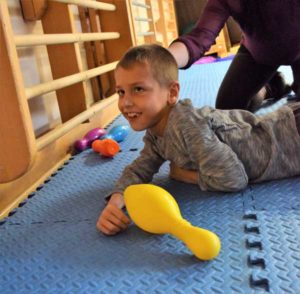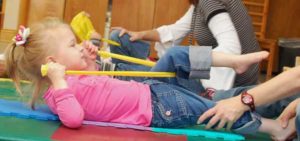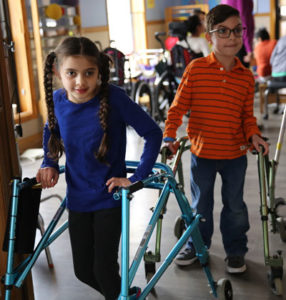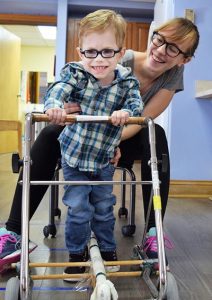Neuroplasticity
Alleviating Stressors for Caregivers
Being a parent or caregiver to an individual with motor impairments can be a challenging journey, requiring immense dedication, love, and support. This parenting and caregiving journey can become overwhelming, often accompanied by emotional and physical strain. The Center strives to alleviate these hardships by both empowering and supporting both individuals with disabilities AND their caregivers.
The demands of caregiving, medical appointments, therapy sessions, and the uncertainties of a child’s future can significantly impact parents’ physical, emotional, and financial well-being, relationships, and overall quality of life. Recognizing and addressing this burden is crucial for creating a supportive environment for both the individual with a disability and their family.
The Intensive Motor Therapy approach used at the Center, is a comprehensive and transdisciplinary treatment approach that focuses on enhancing motor skills and maximizing functional independence. Unlike traditional outpatient therapy, which typically involves shorter and less frequent sessions, our intensive therapy programming offers high frequency and high intensity therapy optimizing the participant’s motor development. Our research based intensive therapy programming is grounded in multi-sensory peer driven learning and principles of Neuroplasticity to make neurological and functional changes for individuals with physical disabilities.
Benefits of the Center’s Intensive Motor Therapy for Parents!
- Expert Guidance and Support: Our therapeutic programs are led by skilled physical and occupational therapists and conductive education teachers who provide specialized care and guidance. Parents/Caregivers can benefit from the expertise and knowledge of these professionals, gaining a deeper understanding of their child’s condition and receiving personalized recommendations to support their child’s progress.
- Empowerment and Skill Acquisition: Through our intensive therapy programs, parents/caregivers are actively involved in their child’s therapy and developing their care plan. Parents and participants are involved in setting their goals and developing their therapy plans of care. The skills learned in therapy can then be incorporated into daily routines to maximize independence.
- Emotional Support and Networking: Participating in Center’s intensive therapy programs provides parents and participants with opportunities to connect with others facing similar challenges. Sharing experiences, challenges, and triumphs can offer emotional support, encouragement, and a sense of community, reducing feelings of isolation that may stem from caring for a person or growing up as a person with special needs.
- Holistic Development: Our intensive therapy programs focus on the overall development of the child, not just their motor skills. As parents witness progress in their child’s physical abilities, they often observe improvements in other areas, such as cognition, communication, and social interactions. This holistic development can alleviate parental concerns about their child’s future and enhance their overall well-being.
- Time Management and Convenience: While our programming does require a more intensive commitment during the therapy period, it can be more time-efficient for parents in the long run. By receiving care from our transdisciplinary staff, participants receive physical and occupational therapy in the same session, decreasing the burden of scheduling separate sessions with multiple practitioners. This decreases mental load of scheduling, transportation, and communication with various practitioners! Caregivers and parents can dedicate more time for work, personal activities, or spending quality time with their families.
CONCLUSION
The Center’s intensive motor therapy programs offer a range of benefits for individuals with motor impairments and their parents/caregivers. By actively involving caregivers in the individual’s therapy journey, the Center helps alleviate parental stressors by providing expert guidance, emotional support, skill acquisition, and fostering a sense of empowerment. As the individual progresses in their motor skills, caregivers witness growth in multiple domains, enhancing overall well-being and optimism for the future. The Center strives to support individuals with physical disabilities in addition to their families to maximize independence throughout the lifespan!
10 Principles of Neuroplasticity: Part 3
 Keep reading for part three, the final installment of the neuroplasticity series. Check out parts one and two if you haven’t read them yet! As a reminder, everything I write about here is found in the article, “Principles of Experience-Dependent Neural Plasticity: Implications for Rehabilitation After Brain Damage.”1
Keep reading for part three, the final installment of the neuroplasticity series. Check out parts one and two if you haven’t read them yet! As a reminder, everything I write about here is found in the article, “Principles of Experience-Dependent Neural Plasticity: Implications for Rehabilitation After Brain Damage.”1
6. Time matters
Different forms of change (plasticity) in the brain happen at different times during training.
The authors highlight how rehabilitation has different levels of efficacy at different points following a brain injury. Specifically, they discussed a study that found that rehabilitation provided 30 days after adults had strokes was far less effective, both functionally and neurologically than rehabilitation provided 5 days after the injury.
So what does this mean for children with CP? First of all, it means that therapy should be started as SOON as possible for babies with a suspected brain injury. Your child should be getting physical and occupational therapy while they are still in the NICU, and this should be continued when they are discharged home. Note that I say “suspected” injury intentionally: sometimes, it takes a while for a baby to be diagnosed with a neuromuscular disorder. This does not mean that the child doesn’t need therapy until they are diagnosed! The sooner therapy is started, the better their outcomes will be.
Secondly, puberty is also an important time to capitalize on neuroplasticity. Check out my previous article on CFI’s blog to read more about critical times for children with CP.
7. Salience matters
The training experience must be meaningful to the person in order to cause change (plasticity).
In every human brain, there’s a mechanism for remembering important things and forgetting less important things. Your brain isn’t able to contain photographic memories of every single experience you have in life, so it filters out which memories are more important to retain, and which ones you can live without.
This concept is true in rehabilitation as well: the experience needs to be meaningful to the child for neuroplasticity to be maximized. Kids need to have sufficient motivation and attention to the task at hand, and higher emotions and excitement help solidify motor learning. This is where conductive education truly excels because of the social context of therapy.
A great example is a popular activity sometimes used in class here called Body Bowling, which is the brainchild of our OT Josephine Boggs. In this activity, rolling is the main motor skill practiced, as kids compete to roll to knock over their bowling pins the fastest. This is a great therapeutic activity because it works on strengthening abdominal muscles, coordinating body parts to complete the movement, stretching shoulders, and so on. Kids don’t care about that, though. They care about winning the competition! It is amazing how much faster they roll during Body Bowling rather than alone as a warm-up activity. Making the activity fun and meaningful, or salient, to the child, not only increases their participation and enjoyment of the activity, but it makes stronger changes in the brain, too.
8. Age matters
Training-induced change (plasticity) occurs more readily in younger brains.
You may remember from part one of this series that I highlighted some good news about neuroplasticity: brains can change at any age! Well, here’s the bad news. While it’s absolutely true that brains at any age can undergo neuroplastic changes, it’s also true that changes are more robust at younger ages. This just serves to underscore the importance of beginning therapy as young as possible, and continuing throughout childhood and adolescence.
9. Transference
Change in function as a result of one training experience can even lead to learning other similar skills.
Researchers have found in a study of neuroplasticity, that after a group of people underwent training for a skill that involved the use of just one finger, neural pathways for use of the whole hand were strengthened. This finding indicates that it’s possible for one kind of training experience to enhance neural connections for other motor skills or body parts.
10. Interference
Brain changes (plasticity) that result in bad habits can interfere with learning good habits.
Neuroplasticity is usually used as a positive term, but not all neuroplastic changes are desirable. The authors of the article describe it well: “brain damage survivors may develop compensatory strategies that are easier to perform (“bad habits”) than more difficult but ultimately more effective strategies acquired through rehabilitation.” Learning those bad habits can make it harder for your brain to learn the “good habits” or better, more efficient, or safer movement patterns. The specifics of what are “good” or “bad” habits for kids with CP is highly specific and individualized to each child, so this is a good thing to ask your child’s therapist or CE teacher about.
As I did in part two, I want to pause for a moment to highlight what all of this has to do with conductive education. The truth is, any kind of experience or therapy will yield some sort of change in the brain, so for any therapist, doctor or clinic to claim to have a monopoly on neuroplasticity is just not true. However, based on the principles we just learned about, there are things you can do to really maximize on neuroplasticity to make those changes bigger and more meaningful. While conductive education indeed does address all ten principles, where I believe conductive education really stands out is with principles four, five and seven (repetition matters, intensity matters, and salience matters). You will be hard-pressed to find a commercially available therapy that provides greater repetition or intensity on a long-term basis than what is provided at the Center for Independence. In addition, the social context provides a rich environment ripe with opportunities to make movement meaningful to children, which provides the much-needed salience that was discussed above.
Congratulations on making it through the ten principles of neuroplasticity! I hope this leaves you with a better understanding of what neuroplasticity even is, and some of the most important factors in how to maximize neuroplasticity. Please leave any comments or questions on our Facebook page!
- Kleim, JA, Jones, TA. (2008). Principles of experience-dependent neural plasticity: Implications for rehabilitation after brain damage. Journal of Speech, Language, and Hearing Research, 51, S225-S239.
10 Principles of Neuroplasticity: Part 2
 Let’s dive right into the first five principles of neuroplasticity. Everything I write about here is found in the article, “Principles of Experience-Dependent Neural Plasticity: Implications for Rehabilitation After Brain Damage.”1
Let’s dive right into the first five principles of neuroplasticity. Everything I write about here is found in the article, “Principles of Experience-Dependent Neural Plasticity: Implications for Rehabilitation After Brain Damage.”1
1. Use it or lose it
Failure to drive specific brain functions can lead to loss of abilities.
This principle is pretty intuitive: if you don’t actively use a functional component of the brain, that part starts to lose the ability to carry out the function it is responsible for. This is true for everyone: say you take piano lessons when you are young, but you stop taking them and don’t touch a piano for 10 years. When you try to play the piano again, you may be able to remember a little bit at best; certainly, you won’t be able to play as well as you did when you were practicing regularly. You literally lost some of the brain cells, and the connections between cells, responsible for playing the piano. You didn’t use it, so you lost it.
This is even true in the context of injured brain tissue. Researchers have found that when one part of the brain is injured, other parts of the brain can take over the function of the injured part. With rehabilitation, the brain literally reorganizes itself to carry out functional tasks.
What this means for kids with CP, is that it’s important to continue actively completing motor tasks, otherwise their brain will adapt and lose the “muscle memory” of how to complete those tasks. Of course, that’s true not just from a neurologic perspective but from a muscle perspective – keeping your brain strong and your muscles strong go hand in hand here!
2. Use it and improve it
Training that drives a specific brain function can lead to improving abilities.
This principle is also easy to understand: the brain will change in response to specific training. When a certain task is learned, the part of the brain responsible for that task grows new brain cells and forms stronger connections between those brain cells. This goes along with a change in output: the person becomes better at doing that task that is trained. Taken together with the first principle of neuroplasticity, there is a strong case for kids with CP to stay active!
3. Specificity
The nature of the training experience dictates the nature of the change in the brain (plasticity).
In this third principle, we get a little more, well, specific about neuroplasticity. The authors explain how different kinds of training can affect what changes happen in the brain. They highlight two examples.
First, the authors note how the biggest changes that happen to the brain are the result of learning new skills. In animal studies, research has shown that learning new skills yields a bigger change in the brain as compared to repetition of previously acquired motor movements. Please note that this doesn’t mean that working on existing skills is not important – remember the first principle, and look ahead at the fourth too – but rather that incorporating new skills into rehab can help maximize neuroplasticity.
Second, the authors explain that there is regional specificity. This means that if you are training a skill that uses a specific body part, for example using only your right hand, the changes that happen to the brain will be largest in the areas of the brain responsible for that movement. Since your right and left sides of your body are controlled by the opposite side of your brain, that means working on something with your right hand is going to make the biggest changes to the left side of the brain, and vice versa.
4. Repetition matters
Change (plasticity) requires sufficient repetition.
Think back to any time you learned a new skill. It could be writing the alphabet, playing the piano, learning to drive, anything. Did you perfect that skill after practicing it just a few times? Probably not. You had to practice it many times before it felt natural and easy to you. That’s because lasting, meaningful neuroplastic changes only happen with repetition.
The same process is at play when learning motor skills. It is not enough to practice going from sit to stand just a few times and expect to have mastered the skill. In order for a child’s brain to undergo meaningful change, it is critical for the skill to be repeated many times.
5. Intensity matters
Change (plasticity) requires intensive training.
Here’s an interesting fact about neuroplasticity that you can impress your friends with. There was an animal study where researchers studied brain changes following practice of a skilled motor task. They divided the animals into two groups: one group completed the task 400 times per day, and the other group, 60 times per day. They found that the animals in the first group had a measurable increase in connections between brain cells in the part of the brain responsible for that task, whereas animals that completed the task only 60 times per day did not.
The takeaway here is that kids with CP need pretty high intensity in their motor program in order to make meaningful changes in their brain.
Phew. We made it through the first five principles of neuroplasticity!
Before we move on the next five, I’d like to pause and consider how the ideas seen so far connect with what conductive education offers. Kids who come to the Center practice a wide range of motor tasks regularly, in a highly intense fashion, with lots of repetition of many familiar tasks, while also being given opportunities to learn new skills on an individualized basis. From what you’ve just read, I hope it’s apparent that conductive education capitalizes on every single one of the first five principles.
Stay tuned for the last installment of the neuroplasticity series!
1. Kleim, JA, Jones, TA. (2008). Principles of experience-dependent neural plasticity: Implications for rehabilitation after brain damage. Journal of Speech, Language, and Hearing Research, 51, S225-S239.
10 Principles of Neuroplasticity: Part 1
 Neuroplasticity – What is it and why does it matter?
Neuroplasticity – What is it and why does it matter?
Neuroplasticity (or neural plasticity) is a buzzword that is often used to advertise particular therapies or techniques, so-called “gurus” of neuroplasticity, or products. In order to make educated decisions about what kind of therapy will be most beneficial for your child, and to use your family income wisely, best to really know what this word means and why you need to care about it.
In this three-part series, I’m first going to define what neuroplasticity is, and introduce ten principles of neuroplasticity. In the next two parts, I’ll go into greater detail with each principle to help you understand what activities and experiences will make the biggest difference as it relates to neuroplasticity. The information I’ll present to you is based largely on research summarized in this article, titled “Principles of Experience-Dependent Neural Plasticity: Implications for Rehabilitation After Brain Damage.”1 If you want to do a deep dive into this concept, reading the full article is a great place to start.
So first, allow me to define Neuroplasticity. The term is a mash-up of two words.
Neural: relating to the nervous system
Plasticity: the capacity to adapt or change
In other words, it refers to the brain’s ability to change itself. As the authors of the article put it, “neural plasticity is the mechanism by which the brain encodes experience and learns new behaviors. It is also the mechanism by which the damaged brain learns lost behavior in response to rehabilitation.” Neuroplasticity is the process in which the brain forms new neurons and lays down new connections between neurons, in response to learning, in order to form a pathway to repeat the learned behavior.
This video does a great job of explaining how neuroplasticity works, too.
Neuroplasticity is a relatively new concept. As recently as a few decades ago, it was believed that our brains were “hardwired” and what we could and couldn’t do was essentially fixed, especially after a certain age, and certainly after an injury to the brain. Good news – researchers have found that this is not true!
However: neural plasticity does not happen In a vacuum. It is experience dependent, and some experiences are going to make a bigger difference than others.
Here’s where it gets interesting! Allow me to introduce you to the ten principles of neuroplasticity, the factors identified as especially important in facilitating neuroplasticity in the context of brain injury.
- Use it or lose it
Failure to drive specific brain functions can lead to loss of abilities. - Use it and improve it
Training that drives a specific brain function can lead to improving abilities. - Specificity
The nature of the training experience dictates the nature of the change in the brain (plasticity). - Repetition matters
Change (plasticity) requires sufficient repetition. - Intensity matters
Change (plasticity) requires intensive training. - Time matters
Different forms of change (plasticity) in the brain happen at different times during training. - Salience matters
The training experience must be meaningful to the person in order to cause change (plasticity). - Age matters
Training-induced change (plasticity) occurs more readily in younger brains. - Transference
Change in function as a result of one training experience can even lead to learning other similar skills. - Interference
Brain changes (plasticity) that result in bad habits can interfere with learning good habits.
Stay tuned for Part 2!
1. Kleim, JA, Jones, TA. (2008). Principles of experience-dependent neural plasticity: Implications for rehabilitation after brain damage. Journal of Speech, Language, and Hearing Research, 51, S225-S239.
When is the Critical Time for Children with CP?
 Have you considered that there is a critical time for therapy for children with cerebral palsy (CP)?
Have you considered that there is a critical time for therapy for children with cerebral palsy (CP)?
From the ages of about zero to three, and again in puberty, children’s bodies and brains grow quickly. Intense therapy is important during those both of those times.
A Few Reasons Why:
It’s normal for bones to grow faster than muscles during growth spurts. This is where growing pains come from! In kids who don’t have CP, their muscles will eventually catch up in length. Spasticity makes this much harder for kids who do have CP, and those muscles get tighter and tighter during rapid growth. It’s so important to keep muscles as flexible as possible, because it’s really hard to fix once they get tight.
When kids grow bigger, their bodies get longer and heavier. Bigger bodies are harder to move and things that used to be easy become harder. Skills have to be practiced regularly, otherwise they might be lost.
Kids brains are growing rapidly during the ages of zero to three and again in puberty. This is the best time to practice good movement patterns! The brain is ready to learn and will remember things that are practiced in these times best. This is the aim of Conductive Education, which is founded on the premise of neural plasticity.
Critical Times Can Be Easily Missed
If a child with CP isn’t diagnosed soon enough, they might not start therapy early enough. If the child gets discharged from therapy when they are doing well right before puberty hits, they might not get therapy when they need it the most.
Karen Pape discusses these concepts in her book, The Boy Who Could Run But Not Walk: Understanding Neuroplasticity in the Child’s Brain:
“Diagnosis-specific treatment should be available during the important first four years of exuberant body and brain growth. There is no logical reason to wait. This is the time when there is the best possible chance for normalizing function.” 209
“Convince a teenager that the intensive, purposeful practice is worth it and he will improve, usually by one or two levels of function. It is a golden opportunity. This period, then, is a prime opportunity to work around established maladaptive habits.” 243
Share Your Thoughts on This Topic
Here are some questions to get the discussion going:
- Did you know about these critical times for therapy?
- What do you think can get in the way of getting therapy during these windows?
- What changes have you seen in your own child during these phases?
- How can we at the Center help support your goals for your child during these times?
Find us on our Facebook page to share you thoughts.
